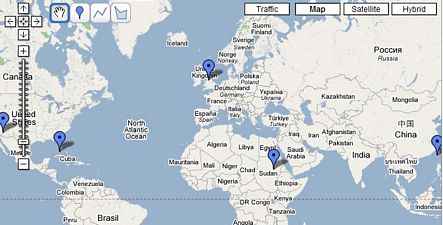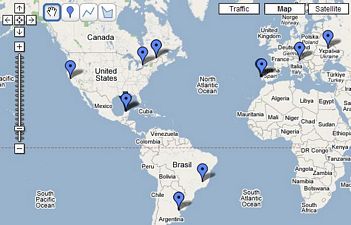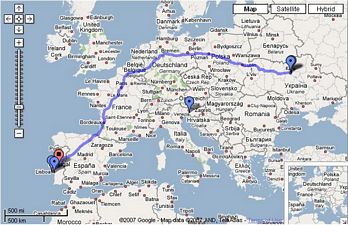 CALL Lesson 11 (June 18, 19 & 21)
CALL Lesson 11 (June 18, 19 & 21)
There are things that we didn't have time to do: (1) explore a link about DST (Daily Saving Time, or "Summer time") sent by our dear friend Dennis Oliver; answer a couple of questions from our teacher-friends in the Google maps you created with messages for them; and, watch a video about bears in Slovenia made by a student of teacher Sasha Sirk. I feel sad, but the end of a school year is always complicated. There are too many things going on…
Today we have another "first time" project. It's a voice chat with someone you don't know and is far away. You prepared the 12 questions for the interview last Thursday, so you're ready for action!!!
Before we start, I'd like to have 4 volunteers – 2 girls and 2 boys – to ask the "mystery guest" three questions each. The interview will be recorded. After it's over, we will listen to it and write a short text about our guest. If there is still time, we will insert that text in a Google map that I created.
Objectives
Students will:
— "experience" their first voice chat in English
— practice language learned in a real situation and with a purpose
— have contact with communication tools, such as Yahoo Messenger and Audacity.
Activities
1. Find 4 students who will ask the "mystery guest" two questions each
2. Open Yahoo Messenger, then a Conference window, and invite guest to join us
3. Open Audacity and click "Record" when the chat starts
4. Start the voice chat
5. Locate where our guest lives in the World Atlas, after s/he says so
6. Thank the guest and stop the recording
7. Listen to the recording and write a short text about him/her
8. Write the text in the Google map created for this lesson.
Enjoy! 
Work done in class by 6.C
An interview with teacher Michael Coghlan in Australia (Be patient with the download! It's worth it!!!)
Google map with a text about teacher Michael
Work done in class by 6.E (19 and 21 Jun)
An interview with teacher Hala Fawzi in Sudan (Be patient with the download! It's worth it!!!)
Google map with a text about teacher Hala
An interview with teacher Cristina Costa in England (Be patient with the download! It's worth it!!!)
Google map with a text about teacher Cristina
Message I sent to teacher Michael Coghlan and his reply
Dear Michael,
Thank you so much for a lovely time during 6.C's interview this morning. The kids were totally fascinated and absorbed. Their eyes and ears were "glued" to the screen and speakers the whole time. I'm sure that most of them just couldn't believe their eyes, especially, their ears.
First, I was amazed at their interest in the surprise about to come when I announced what we were going to do for the rest of the lesson. My amazement continued with the degree of interest and absorption in the dialogue that was taking place. Finally, I was totally surprised by their interest in the recording. I wanted to listen to it for a while to see if everything was ok. It is!!! And when I was going to stop, because I knew they had understood enough to be able to write the text, they asked to listen to all of it. Wow!!! I decided to make some pauses and comment on the content (such as the time difference and the temperature) or explain something (the southern hemisphere and the different season, as well as the difference in size between a twon and a city). It was fantastic!
Then they wrote the text about you in the Google map (with a little guidance from me), always following the sequence of the questions. They did a great job with the interview questions and the text.
It was a fabulous and very special feeling for me to see those excited and happy expressions. It was a real and totally unexpected treat! When I asked if this had a been a "grand finale", they all said "Yeeeeeesssss!!!" at once.
I'll be uploading the recording tomorrow after the second class interviews Hala at the same time as today. You're welcome to take part. BTW, I asked 6.C to keep this a secret from the other class, because they had enjoyed the "surprise" this morning. I sure hope they can keep a secret.
I'll send the rest of the links tomorrow: "CALL lessons" blog and recording.
Thank you for being there for me and 6.C. It'll be an experience they will never forget! :-))
Warm hugs, Teresa
Fantastic Teresa! And what a great paragraph they created on the map. Thank you for inviting me to do this, and for this great feedback.
– Michael
Message I sent to teacher Hala Fawzi and her reply
Dear Hala,
It was another fantastic lesson! "Thank you" so much for making it possible for my students. They behaved very well and were also "glued" to the screen and speakers.
Right from the moment the students came in I felt that they were expecting something. Maybe someone from yesterday's class wasn't able to keep the secret!!! They seemed very anxious to know what their "surprise" would be, but didn't ask. I could feel their curiosity growing as 9:00 approached and I started to go over the interview with them.
I was very happy that two of the weaker students, Barbara and Pedro, volunteered to ask you questions. The other two, Catarina and Francisco, are good students.
They loved listening to the recording, writing the text about you and seeing your photo. I explained that you are from a different culture and that you dress differently in your country. Some also noticed a couple of differences from me in terms of pronunciation, which is very curious. Good ear for languages!!!
Everything is now in the blog, the recording of the interview and the text in the Google map. I love both, especially the interview.
Once again, I feel that this is an experience they'll never forget! :-))
Warm hugs, Teresa
Good evening there! I was trying to reply to your last email, but my yahoo mail seems to have gone crazy:). I just wanted to thank you for a very new experience that I have not gone through before. Talking to kids synchro in their class and helping them to learn! That was amazing to me too, not only to your kids.I loved the map and the interview.
Beijinhos, Hala
Message teacher Cristina sent after the interview and my reply to her
Teresa!
What a great class! What a great blog.
I got really emotional at the end. I had tears in my eyes.
Thank you so much for getting me involved.
It's projects like this that make me believe that it is worth all the hard work.
Way to go.
thank you once again for the shining example.
beijinhos, Cris
Dear Cristina,
"Thank you" for being there for me and 6.E this morning. I was happy to be able to have you "live" with us and to have four students in the class who were not present on Tuesday experience this synchronous event. Three of them interviewed you: Martim, Duarte and Daniela from Moldova. I'm sure they loved it as much as you did.
I'm listening to the recording as I'm writing: it's very cute. We can hear all the interaction going on. We are all so lively! And I've just noticed that you were "emotional" at the end. You're such a dear friend. 🙂
The text may have a couple of minor incorrections, because we didn't have time to listen to the recording. It was from memory and things I'd jotted down on the whiteboard.
They loved to interview you and it was a great second "grand finale" for this class.
Beijinhos, Teresa
* * * * * * * *
Report on CALL Lesson 11
6.C (18Jun07): Ten minutes before the interview started, we went over the questions they had written in class last Thursday. I told the students that they were going to interview a mystery guest, a friend of mine who lived far away. Each of the volunteers – Rodrigo, InêsT, Lourenço and Margarida – would ask 3 questions. The interview was going to be recorded and then we would listen to the recording to write a text about the interviewee.
I asked them to behave and not make much noise with the chairs when they changed partners at the computer!!! 😉
We used my laptop, a cable connection, a video projector and speakers. The lesson went on exactly as planned above: (1) interview with timely comments (= comentários pontuais) from me, (2) a look at the World Atlas to locate Australia and see the distance between both countries, (3) listening to the recording and (4) writing a text in a Google map I had created for this purpose.
This was a memorable lesson for the students, for me and, I dare say, for Michael Coghlan.
6.E (19Jun07): Ten minutes before the interview started, we went over the questions they had written in class last Thursday, included a comment about the weather – it was pouring at the time!!! – and repeated the questions. I told the students that they were going to interview a mystery guest, a friend of mine who lived far away. Each of the volunteers – Catarina, Pedro, Bárbara and Francisco – would ask 3 questions. The interview was going to be recorded and then we would listen to the recording to write a text about the interviewee.
I asked them to behave very well and not to make much noise with chairs when changing partners at the computer!!! 😉
We used my laptop, a cable connection, a video projector and speakers. The lesson went on exactly as planned above: (1) interview with timely comments (= comentários pontuais) from me, (2) a look at the World Atlas to locate Sudan (they located Khartoum while we listened to the recording) and see the distance between both countries, (3) listening to the recording and (4) writing a text in the Google map I created for yesterday's class.
This was a memorable lesson for the students, for me and, I dare say, for Hala Fawzi.
Two days later I was able to have the Computer Room with 6.E again and have Cristina Costa be interviewed by them. While they wrote down their self-evaluatuion text, I reordered some questions and suggested 2-3 that they translated correctly. This time the volunteers were boy-girl-boy-girl: Martim, Patrícia, Duarte and Daniela.
It was fabulous! I even got to talk about Cristiano Ronaldo, the famous Portuguese football player in Manchester United.




 Wrapping up (= resumindo) two years online
Wrapping up (= resumindo) two years online
 CALL Lesson 11 (June 18, 19 & 21)
CALL Lesson 11 (June 18, 19 & 21)
 CALL Lesson 10 (May 28-29)
CALL Lesson 10 (May 28-29)
 CALL Lesson 9 (May 7-8)
CALL Lesson 9 (May 7-8)



 CALL Lesson 8 (Apr 23-24)
CALL Lesson 8 (Apr 23-24) CALL Lesson 7 (Feb 5-6)
CALL Lesson 7 (Feb 5-6)
 CALL Lesson 6 (Jan 22-23)
CALL Lesson 6 (Jan 22-23)
 CALL Lesson 5 (Jan 8-9)
CALL Lesson 5 (Jan 8-9)

 CALL lesson 4 (Dec 4-5)
CALL lesson 4 (Dec 4-5)